Papers by kolawole adekola
Cultural Resource Management
Yoruba Studies Review, 2021
The Yoruba of South west Nigeria pride themselves as a “nation” with a rich cultural heritage. Ti... more The Yoruba of South west Nigeria pride themselves as a “nation” with a rich cultural heritage. Tis jealously guided heritage believed to have been handed down from ancient times has however suffered greatly from modern influences owing to contacts with foreign cultures. Tis essay highlights the measures to preserve the Yoruba heritage and the militating problems in the light of the unbridled contacts with foreign cultures. The paper also provides evidence to suggest that the Yoruba, just like every other ethnic groups in Nigeria, could have fashioned their own developmental frameworks but for the imposition of foreign ideas/ideals.
HAL (Le Centre pour la Communication Scientifique Directe), Apr 18, 2023
Encyclopedia of Global Archaeology, 2014
npj Biofilms and Microbiomes, 2016
Encyclopedia of Global Archaeology, 2014
Facial Approximation and Craniofacial Superimposition Facial Approximation and Craniofacial Super... more Facial Approximation and Craniofacial Superimposition Facial Approximation and Craniofacial Superimposition, Fig. 5 Mean soft tissue thicknesses, at craniometric landmarks, as collated from the literature for adults and subadults. (Illustrations and data reprinted from Stephan and Simpson (2008a, b), with permission from Blackwell-Wiley) Facial Approximation and Craniofacial Superimposition 4173
This article examines the diverse research views on the history of urban centres in West Africa. ... more This article examines the diverse research views on the history of urban centres in West Africa. I focus on the characteristics of some of the past urban centres at the time of their peak populations as revealed from the archaeological record. This article concludes that the quantum of research in West Africa is insignificant relative to the vast potentials for research to be conducted there. There is a pressing need for more research to obtain a fuller understanding of the histories of these past urban centres in West Africa.

Introduction This chapter is derived from archaeological engagements with the Esie. and Igbaja co... more Introduction This chapter is derived from archaeological engagements with the Esie. and Igbaja communities in northern Yorubaland. Active interactions between communities and other heritage and tourism stakeholders within the framework of heritage protection, management, and development are not common in this West African subregion. Here, we identify major hindrances for productive interactions between and among the different heritage management stakeholders and local communities. Prominent are detrimental experiences under colonial rule, lack of awareness, religious intolerance, looting and other illegal subsistence activities related to the acquisition and sale of cultural items, non-adherence to traditional social factors (i.e., taboos) that otherwise protect and preserve cultural entities, unethical archaeological practices, and uncontrolled degradation of sacred forests that hitherto successfully preserved and protected heritage materials. Although these diverse negative impacts tend to dominate our experience, we want to highlight positive trends that show that communities' initiatives based on understanding of archaeological goals have led to rich and reciprocal relationships being developed in the two communities we discuss here. We offer suggestions about a future-oriented strategy for community engagements relating to heritage protection, management, and development.
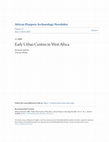
This article examines the diverse research views on the history of urban centres in West Africa. ... more This article examines the diverse research views on the history of urban centres in West Africa. I focus on the characteristics of some of the past urban centres at the time of their peak populations as revealed from the archaeological record. This article concludes that the quantum of research in West Africa is insignificant relative to the vast potentials for research to be conducted there. There is a pressing need for more research to obtain a fuller understanding of the histories of these past urban centres in West Africa. Introduction The term urbanism has generated much furore amongst scholars over the years. Various scholars using their local experiences have used several criteria to define urbanism. For example, Dickson (1947 in Andah 1976) defined an urban centre as a compact settlement engaged in non-agricultural occupations. Louis Wirth (1938) posited that a city is a relatively dense and permanent settlement of socially heterogeneous individuals. Service (1962) regarded ...
This articles examines the diverse research views on the history of urban centres in West Africa.... more This articles examines the diverse research views on the history of urban centres in West Africa.I focus on the characteristics of some of the past urban centres at the time of their peak populations as revealed from the archaeological record.This article concludes that the quantum of research in West Africa is insignificant relative to the vast potentials of research to be conducted here. There is a pressing need for more research to obtain a fuller understanding of the histories of these past urban centres in West Africa.
Encyclopedia of Global Archaeology, 2014
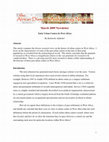
This article examines the diverse research views on the history of urban centres in West Africa. ... more This article examines the diverse research views on the history of urban centres in West Africa. I focus on the characteristics of some of the past urban centres at the time of their peak populations as revealed from the archaeological record. This article concludes that the quantum of research in West Africa is insignificant relative to the vast potentials for research to be conducted there. There is a pressing need for more research to obtain a fuller understanding of the histories of these past urban centres in West Africa. Introduction The term urbanism has generated much furore amongst scholars over the years. Various scholars using their local experiences have used several criteria to define urbanism. For example, Dickson (1947 in Andah 1976) defined an urban centre as a compact settlement engaged in non-agricultural occupations. Louis Wirth (1938) posited that a city is a relatively dense and permanent settlement of socially heterogeneous individuals. Service (1962) regarded ...
Encyclopedia of Global Archaeology, 2014
Encyclopedia of Global Archaeology, 2014
Encyclopedia of Global Archaeology, 2014
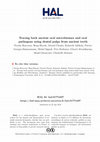
npj Biofilms & Microbiomes, 2016
Ancient dental pulps are highly precious samples because they conserve DNA from humans and blood-... more Ancient dental pulps are highly precious samples because they conserve DNA from humans and blood-borne pathogens for ages. However, little is known about the microbial communities present in dental pulps. Here, we analyzed ancient and modern dental pulp samples from different time periods and geographic regions and found that they are colonized by distinct microbial communities, which can be differentiated from other oral cavity samples. We found that despite the presence of environmental bacteria, ancient dental pulps conserve a clear and well-conserved record of oral microbes. We were able to detect several different oral pathogens in ancient and modern dental pulps, which are commonly associated with periodontal diseases. We thus showed that ancient dental pulps are not only valuable sources of DNA from humans and systemic infections, but also an open window for the study of ancient oral microbiomes.



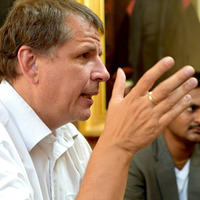


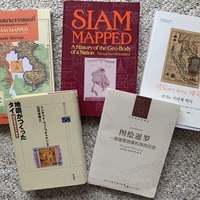




Uploads
Papers by kolawole adekola